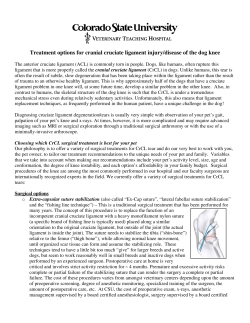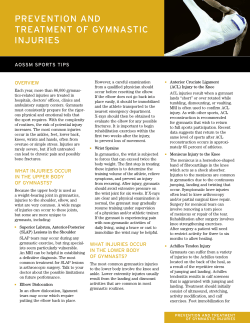
Document 141507
BRIGHAM AND WOMEN’S HOSPITAL Department of Rehabilitation Services Physical Therapy Standard of Care: Medial Collateral Ligament Sprain ICD 9 Codes: 844.1 Case Type / Diagnosis: The anatomy of the medial knee has been divided into 3 layers, consisting of the deep fascia of the thigh, the superficial medial collateral ligament (MCL) and the deep MCL and posteriomedial joint capsule1. The superficial MCL is the primary restraint to valgus loading and the deep MCL and posteromedial capsule are secondary valgus restraints at full extension. Most isolated MCL strains occur as a result of a valgus force from a direct trauma to the lateral aspect of the knee. Concomitant injuries involving the cruciate ligaments are also common, especially in the presence of a rotation moment at the knee joint. Most lesions occur at the femoral origin or in the midsubstance over the joint line. Isolated MCL injuries rarely produce large joint effusions, since the MCL is extra-articular. Classification of MCL injuries: The severity of injuries to the medial knee is graded according to the amount of opening of the joint space when a valgus stress is applied to the knee at 0 and 30 degrees of flexion.2 Opening of 0-5 mm indicates a Grade I tear, 6-10 mm a Grade II tear and more than 10 mm a Grade III tear.1 Anterior cruciate ligament (ACL) injuries occur with up to 78% of Grade III MCL tears.3 The amount of laxity in each position of flexion is indicative of the number of medial structures injured. Valgus laxity at 30 degrees of flexion but not at 0 degrees of flexion suggests an isolated MCL injury. Valgus laxity at both 30 and 0 degrees indicate injury to the MCL, posterior oblique ligament (POL) and most likely the ACL.1 Indications for Treatment: Indications for treatment include pain, swelling, instability, loss of mobility and function. Contraindications / Precautions for Treatment: The presence of a large effusion could be indicative of a meniscal tear, cruciate injury, or fracture. Evaluation: Medical History: Review past medical history (PMH), pertinent diagnostic tests, imaging and workup, physicians’ notes in longitudinal medical record (LMR). History of Present Illness: Chief complaint or mechanism of injury. The patient may report a popping or tearing sensation in the medial region of the knee. Note date of injury Standard of Care: Medial Collateral Ligament Sprain 1 Copyright © 2008 The Brigham and Women's Hospital, Inc., Department of Rehabilitation Services. All rights reserved or duration of symptoms, treatment to date, reason for referral, prior level of function, current functional limitations, previous Physical Therapy, and past or current use of orthotics. Also inquire about patient’s own goals. Social History: Family/social support, employment, physical activity level, hobbies, sports, ADL’s and any pertinent functional limitations. Medications: Note relevant medications including NSAIDS, muscle relaxants and other analgesics. Examination (Physical / Cognitive / applicable tests and measures / other) This section is intended to capture the most commonly used assessment tools for this case type/diagnosis. It is not intended to be either inclusive or exclusive of assessment tools. Pain: typically well-localized to medial aspect of knee1 Palpation: localized soft-tissue swelling and tenderness over medial knee1 Range of Motion (ROM): Active and passive ROM of knee joint Joint Mobility: patellar glides, femorotibial glides Strength: hip and knee musculature; note quality of VMO recruitment Sensation: may be impaired to light touch due to localized swelling Girth measurement: to assess for swelling, atrophy Special Tests4: ligament stability tests, especially valgus stress at 0 and 30 degrees, Lachman, anterior drawer; McMurray Posture/alignment: note any varus or valgus deformities at knee joints; knee hyperextension; weight bearing avoidance or intolerance on affected lower extremity. Proprioception: if possible, assess single leg stance, compare to uninjured leg Gait: note if antalgic, uneven stride; decreased stance on affected limb; cadence; ask patient to increase speed to brisk walk and note further impairments; note balance and safety with locomotion; assess stair climbing ability. Note, if any, type of device(s)- cane, shoe lift. Functional Outcomes: using the Lower Extremity Functional Scale (LEFS) Differential Diagnosis: medial knee contusion, ACL tear, medial meniscal tear, patellar subluxation or dislocation and physeal fracture (in skeletally immature patient). Assessment: Problem List • Pain • Impaired gait • Decreased ROM • Decreased muscle strength • Instability • Posture dysfunction Standard of Care: Medial Collateral Ligament Sprain 2 Copyright © 2008 The Brigham and Women's Hospital, Inc., Department of Rehabilitation Services. All rights reserved • Impaired muscle performance • Limited function (see subjective portion of examination) • Knowledge deficit regarding condition, self-management, home program, prevention Prognosis: Grades I and II: Good prognosis with return to functional activities and sport following a structured rehabilitation program including strengthening and proprioception.5 Grade III: Good prognosis with isolated MCL tears, again with structured rehabilitation program as above. Edson6 suggests that a longer period of immobilization is important, to promote the healing of both the superficial and deep fibers of the MCL. However, gentle ROM exercises as early as is appropriate are crucial to prevent joint arthrofibrosis associated with a longer immobilization period. Goals: Short term (2-4 wks) and long term (6-8 wks) goals may include but are not limited to: 1) Resolve pain 2) Gain full ROM 2) Normalize gait pattern without assistive device 3) Improve muscular strength and endurance 4) Return to normal ADL’s/IADL’s 5) Independence with home exercise program 6) Return to sports activities. Functional brace may be warranted to provide medial and lateral knee support. Treatment Planning / Interventions Established Pathway ___ Yes, see attached. _X_ No Established Protocol ___ Yes, see attached. _X_ No Standard of Care: Medial Collateral Ligament Sprain 3 Copyright © 2008 The Brigham and Women's Hospital, Inc., Department of Rehabilitation Services. All rights reserved Interventions most commonly used for this case type/diagnosis. This section is intended to capture the most commonly used interventions for this case type/diagnosis. It is not intended to be either inclusive or exclusive of appropriate interventions. 1. Therapeutic exercises to increase: lower extremity ROM, especially extension; muscle strength, flexibility and proprioception. Include agility drills and sport-specific exercise. 2. Modalities such as ice, ultrasound and high-voltage electrical stimulation to decrease inflammation and pain 3. Patellar and soft tissue mobilizations 4. Gait training for efficient and effective pattern (consider DME as appropriate) 5. Instruction in home exercise program Frequency & Duration: 1-2/week, for duration of 6-12 weeks, depending on grade of injury, patient’s progress, patient’s goals with respect to returning to sports, and/or presence of any concomitant injuries Patient / family education: 1. Pain and edema management 2. Home exercise program 3. Sports specific training 4. Gait training Recommendations and referrals to other providers: 1. Orthopedist 2. Orthotist 3. Rheumatologist 4. Physiatrist 5. PCP Re-evaluation / assessment Time Frame: every 30 days and/or prior to visit with physician Other Possible Triggers for re-evaluation are: 1. Significant change in the signs and symptoms, fall or acute trauma 2. Failure to progress per established short-term goals 3. Complications or worsening of associated conditions Standard of Care: Medial Collateral Ligament Sprain 4 Copyright © 2008 The Brigham and Women's Hospital, Inc., Department of Rehabilitation Services. All rights reserved Discharge Planning Commonly expected outcomes at discharge: 1. Resolution of pain 2. Increased AROM and strength 3. Increased lower extremity muscle flexibility 4. Return to pre-injury function and sports activities Patient’s discharge instructions: 1. Progressed home exercise program 2. Sports specific training 3. Education regarding injury prevention; use of brace Authors: Marie-Josee Paris, PT April 2008 Reviewed by: Amy Butler, PT, OCS Mike Cowell, PT Leigh DeChaves, PT, OCS Standard of Care: Medial Collateral Ligament Sprain 5 Copyright © 2008 The Brigham and Women's Hospital, Inc., Department of Rehabilitation Services. All rights reserved REFERENCES 1. Azar FM. Evaluation and treatment of chronic medial collateral ligament injuries of the knee. Sports Med Arthrosc. 2006;14:84-90. 2. Hughston JC, Andrews JR, Cross MJ, Moschi A. Classification of knee ligament instabilities. part I. the medial compartment and cruciate ligaments. J Bone Joint Surg Am. 1976;58:159-172. 3. Sims WF, Jacobson KE. The posteromedial corner of the knee: Medial-sided injury patterns revisited. Am J Sports Med. 2004;32:337-345. 4. Magee DJ. The knee. In: Orthopedic Physical Assessment. Second ed. Philadelphia: W.B. Saunders Company; 1992:372. 5. Giannotti BF, Rudy T, Graziano J. The non-surgical management of isolated medial collateral ligament injuries of the knee. Sports Med Arthrosc. 2006;14:74-77. 6. Edson CJ. Conservative and postoperative rehabilitation of isolated and combined injuries of the medial collateral ligament. Sports Med Arthrosc. 2006;14:105-110. Standard of Care: Medial Collateral Ligament Sprain 6 Copyright © 2008 The Brigham and Women's Hospital, Inc., Department of Rehabilitation Services. All rights reserved
© Copyright 2025





















